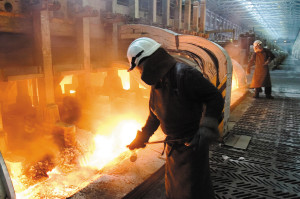 The use of recycling in the manufacturing process of metals has been a main driver of improvements in energy efficiency within the industry. Indeed, according to the US Energy Information Administration, the production of iron, steel and aluminum is a highly energy intensive process accounting for 10% of total manufacturing energy use in the USA.
The use of recycling in the manufacturing process of metals has been a main driver of improvements in energy efficiency within the industry. Indeed, according to the US Energy Information Administration, the production of iron, steel and aluminum is a highly energy intensive process accounting for 10% of total manufacturing energy use in the USA.
Primary production, in which steel is made from iron ore and aluminum from bauxite ore, is energy intensive. However, secondary production, which involves the use of recycling scrap to make steel and aluminum, is much more energy efficient.
The Environmental Protection Agency estimates that secondary steel production uses about 74% less energy than the production of steel from iron ore, while the US Department of Energy reports that secondary aluminum production requires 90% less energy than primary production. Secondary production accounts for nearly 60% of US aluminum production (counting both old and new scrap), while primary production accounts for almost 40%. Similarly, recycling is used in most steel production.
According to the US Geological Survey (USGS), 40% of US steel production in 2011 came from basic oxygen furnaces (BOF), whose inputs are almost 80% pig iron (molten iron), whereas 60% of production came from electric arc furnaces (EAF), which use more than 90% scrap. Primary production of steel usually involves using a blast furnace to produce molten iron from iron ore, coal and coke, using fluxing agents such as limestone to remove impurities. The molten iron (pig iron) is then converted into steel by a BOF. Secondary production facilities typically use an electric arc furnace (EAF), with scrap providing the main input. In an EAF, scrap is melted using electric arcs, which can be supplemented with natural gas fueled combustion. The high energy use of a blast furnace is eliminated by secondary production, with the exception of small quantities of pig iron used as an input along with scrap. Another alternative to using a blast furnace to produce pig iron is using direct reduced iron (DRI), a process typically fueled by natural gas. Scrap continues to be the primary raw material used in EAFs, but DRI may become a larger component in the raw materials mix.
Iron and steel scrap is classified as home, old, and new scrap. Home, or mill, scrap is generated in the steel mill during production and is recycled in the same facility. Old scrap is postconsumer scrap. The largest source of old scrap is discarded automobiles, along with appliances, machinery, worn out railroad cars and tracks, demolished steel structures, and other steel products. New scrap is produced during the manufacturing process.



